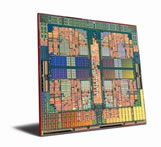Final Thoughts
While initial reports might have scared many away from the Phenom, in reality it's not that bad at all. While it is hard to make a one-sided conclusion about the Phenom's performance, as we just saw the results can greatly vary depending on the program tested, overall it came really close to Intel's Core 2 Quad which we believe to be a phenomenal CPU (no pun intended).
When testing using business applications, the Phenom processors were able to stick with the Core 2 Quad Q6600 for the most part. In fact, the Phenom 9700 and 9900 were considerably faster in a few tests. The Phenom also showed superior processing power for tasks such as compressing files, where even the Phenom 9500 was able to defeat the Q6600.
But performance tended to fluctuate, which was again evident in the gaming benchmarks. While the Phenom processors were all much slower than the Core 2 competition in Unreal Tournament 3, Company of Heroes and Prey, they were able to provide competitive performance in Crysis and F.E.A.R.
Clearly those more interested in gaming are certainly better off with a Core 2 Duo for now, as even the Core 2 Quad processors do not provide a performance advantage to justify the added cost. The Core 2 Duo E8400 has really stirred things up even more for AMD as this new Intel processor features a 6MB L2 cache, operates at 3.0GHz, uses a 1333MHz FSB and is built using a 45nm design process. In other words, you get its incredible performance for just $183.
Furthermore, while the upcoming B3 stepping Phenom processors are still on the back burner, Intel is preparing to unload the new 45nm quad-core processors just before the B3-revised Phenoms arrive. If AMD thought they were sailing through rough seas at the moment, we fear things could even get worse given Intel's aggressive pricing strategy for the upcoming 45nm processors.
The good news is that we have seen a great deal of potential from the AMD Phenom processors, and with a little more work they could become great alternatives to the Core 2 competition. For the moment though it almost seems as the Phenom design is a little ahead of its time, with this true quad-core design still waiting for software developers to catch up.
Arguably, the most technologically advanced game on the planet right now is Crysis, and this just so happened to be a game where the Phenom processors did quite well. Granted they did not wipe the floor with the Core 2 Quad Q6600, but at the very least provided competitive results.
But if today was all that mattered and we saw enthusiasts as the prominent target market for these processors, what we see hurting the value of these new Phenom processors is their lack of overclocking headroom. The retail Phenom 9500 and 9600 CPUs that we purchased really struggle to squeeze another 200MHz out, while the Phenom 9900 engineering sample could hit 3000MHz thanks to an unlocked multiplier. So with limited overclocking headroom the Phenom loses a lot of points in terms of value, as the average Core 2 processor is happy to squeeze out another 1000MHz+ on top of the default operating frequency.
